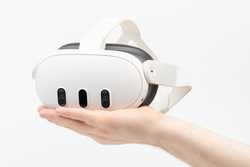Earbuds vs. Headphones: How to Make a Sound Decision

Our evaluations and opinions are not influenced by our advertising relationships, but we may earn a commission from our partners’ links. This content is created by TIME Stamped, under TIME’s direction and produced in accordance with TIME’s editorial guidelines and overseen by TIME’s editorial staff. Learn more about it.
If you’re in the market for a new way to listen to music, podcasts, and other audio, you may wonder whether earbuds or headphones will work best for you. Both earbuds and headphones offer a variety of options and a range of price points, with options to fit each person’s needs.
Narrowing down your decision doesn’t need to be stressful because there’s no correct answer. Both earbuds and headphones offer pros and cons, so the best option is often what will be the best choice for you. This guide will help you define what earbuds and headphones are, the features they offer, and which will be the right fit (pun intended).
Headphones and earbuds are both meant to deliver sound to your ears and your ears alone. But there are subtle differences between what is called a headphone and what is called an earbud. Generally speaking, headphones are outside your ears and earbuds are compact drivers that fit within each ear. Within those categories you have on-ear or over-ear headphones and earbuds that hang inside your ears versus earbuds that have a hook that goes over your ear’s antihelix and lobe (the parts that stick out of your head).
Both headphones and earbuds can connect to audio devices wirelessly or with a wired connection, depending on the model.

Over-ear headphones are a great choice for those who value sound quality. They have two large ear pads that surround the ear with soft foam, and they’re connected by a band that is worn over the head.
They are comfortable for long listening sessions because they place minimal pressure on the ear itself. Due to their heavier weight and larger size, they are a better choice for listening at home versus on the go. Over-ear headphones are best for sealing out noises from the outside and rendering the highest fidelity audio quality.
On-ear headphones have two smaller earpads that rest directly on the ear. They are usually smaller and lighter than over-ear headphones, making them very comfortable. They differ from over the ear headphones—as they don’t have a seal around the ear—making it more difficult to block out outside noise.
Because of their lightweight materials, they are some of the most affordable headphones you can buy. On-ear headphones are best for those who are budget conscious but looking for a good sound experience.
Closed-back headphones have a seal all the way around the back and only allow sound to escape where it reaches your ear, making them ideal for traveling on loud planes, trains and automobiles. Closed-back headphones work great for commuting and public places because of their isolation and they allow minimal sound to escape.
This seal prevents outside noise from coming in, resulting in better isolation. The trade-off is that music may not sound as natural because low frequencies can be amplified. However, if you love heavy bass in your music, they may be a perfect choice.
Open-back headphones allow air to pass through the earpads, meaning they also aren’t great at blocking out sound. While this may pose a challenge for commuters and loud environments, they are a great choice for those listening at home.
Because the air is able to pass freely, low-frequency build-up isn’t as much of a concern as with closed-back earphones; as a result, your music sounds more natural. They also can be cooler and potentially be worn for longer than closed-back because they allow more airflow through the ear pads.
Wireless earbuds are two independent speakers that fit into your ear. They connect to your audio source via Bluetooth. Wireless earbuds are very portable due to their small size and are unobtrusive because they have no cords.
They can also come with a case that charges the earbuds while they are not in use. Some cases even offer wireless charging. Wireless earbuds offer a portable, all-in-one listening experience that is hard to beat— making them the best choice for those who are on-the-go.
Wired earbuds are connected via a wire, which connects to your audio source. These headphones are still very portable; however, they are a little less flexible because the wire needs to reach your audio source.
Wired earbuds can also be one of the more affordable options in the universe of earbuds. Wired earbuds are a great option for those who are looking for good sound quality without taking up much space in their bag.
Earhook earbuds have an attachment on the bud that wraps around the outer ear to provide additional support and security, making them ideal for active workouts. They come in both wired and wireless forms.
Earhook earbuds are popular for runners and working out because they are the least likely to fall out, and they are just as portable as standard earbuds and offer the same features.
Ear fin earbuds have a fin on each bud that sits in the mold of the ear. They are similar to ear hook earbuds in that they provide more security and support. They also can come in wired or wireless varieties.
They’re an excellent choice for budget-conscious shoppers who want good sound, great battery life, and decent noise cancellation.
Read Article: The Best Headphones of 2024: From Noise-Canceling Options to Comfortable Earbuds for Workouts
It is hard to compare the sound quality of earbuds versus headphones due to the vast range of models available. Generally, headphones have been used by musicians for a transparent sound; however, with the popularity of IEMs (In-ear monitors), earbuds can sound just as good as headphones. Sound quality will ultimately come down to a user's preference and the price they want to pay.
Following sound quality, many users may rank comfort among the top features they need for their preferred listening device. For overall comfort, over-ear headphones are preferred. The pads put virtually no pressure on the ear and can be worn comfortably for long periods of time. They are also preferred by wearers who don’t want to put anything in their ears. However, earbuds are very comfortable for most users, and the tips of earbuds can be replaced with different sizes and materials (foam inserts or rubber) to suit the users' preferences.
Depending on how you use your headphones or earbuds, portability will be a big factor in determining which is right for you. While both can be used almost anywhere, earbuds are the clear winner for portability. They are smaller, lightweight, unobtrusive, and offer built-in sound isolation. Another plus is that many wireless earbuds come with a charging case that keeps your earbuds charged when you’re not using them. Battery life can be a factor when traveling. Some wireless headphones can be used wired if you choose and therefore work even when they’re not charged. Wireless earbuds do not offer this handy backup feature.
If you have others around you or you’re in a loud environment, you’ll want headphones or earbuds with some isolation. Earbuds provide the cheapest passive isolation because they fit into your ear canal, sealing off the outside world. Many closed-back headphones offer advanced active noise canceling technology, which can completely seal out the outside world. Many even offer connectivity to apps, and you can control how much outside noise is let in or blocked out.
Both headphones and earbuds offer a range of different features. Both offer wireless Bluetooth audio eliminating cords. Both can offer noise canceling features. Earbuds offer more ways to customize the fit to the user, including foam or rubber buds and fins or hooks to help with stability. Other features to look out for are noise canceling, app connectivity, listening modes or adjustable EQ’s, and even custom molded carrying cases.
There are models in all price ranges for both earbuds and headphones of varying quality and features. Earbuds are smaller and, therefore, can sometimes be cheaper than headphones because they use fewer materials. Generally, the more you spend, the better the quality product you will receive, which is true of both headphones and earbuds.

The ultimate question, headphones or earbuds?
To prevent damage to developing eardrums, headphones are the best pick for kids. They keep the sound further away from the delicate workings of the inner ear. It is also essential to limit the decibel level, so kids are not inadvertently harming their ears. Look for headphones with apps that can monitor decibel readings and limit how loud they can get.
To get in the zone and isolate outside sounds, all while staying out of your way, earbuds are the best pick for working out. Wireless earbuds are lightweight and unobtrusive. They are secure and remain in your ear even through the toughest workouts. Some brands offer earbuds that are water resistant so that sweat and light rain won’t stop the music no matter how hard your work out goes.
Flights have a lot of ambient noise, and you’re packed into close quarters. Active noise canceling headphones or earbuds would be the best bet for air travel. Closed-back headphones are more comfortable for long periods of wearing and offer superior noise cancellation and isolation. However, earbuds also offer the same noise canceling technology and are more portable due to their smaller size.
If you’re in the studio mixing or listening in another quiet environment, the sound quality of open-back headphones is tough to beat. They offer a flat frequency response and a more natural sound. It’s important to note that they will leak some sound to the room around you and do not offer as much isolation as closed-back headphones.
Earbuds are a good choice for commuting due to their small size. They offer isolation, so you won’t disturb those around you. They can be tucked away quickly and are discrete. A wireless pair of earbuds with a charging travel case will ensure you can stay connected throughout the workday.
Earbuds and headphones are some of the most personal electronics you can buy. They’re a wearable accessory that not only has to look and feel good but sound good as well. Whether you wear them all day or just for moments at a time, they must fit your personal needs. Now that you know the differences between earbuds and headphones, you can make an informed decision on which to buy based on the features you need.
Read Article: The Best Wireless Headphones for Perfect Sound in Every Situation
The information presented here is created by TIME Stamped and overseen by TIME editorial staff. To learn more, see our About Us page.



